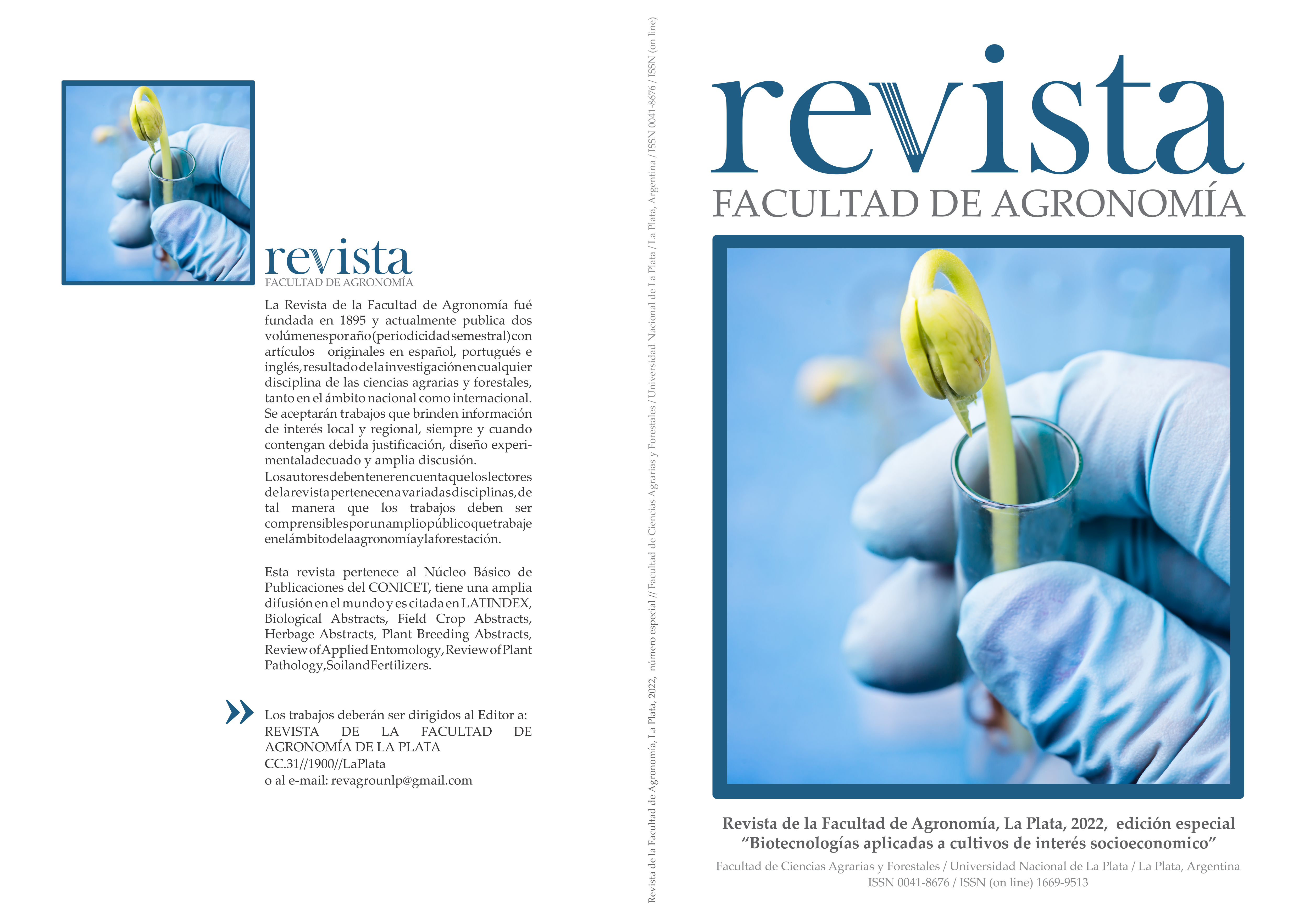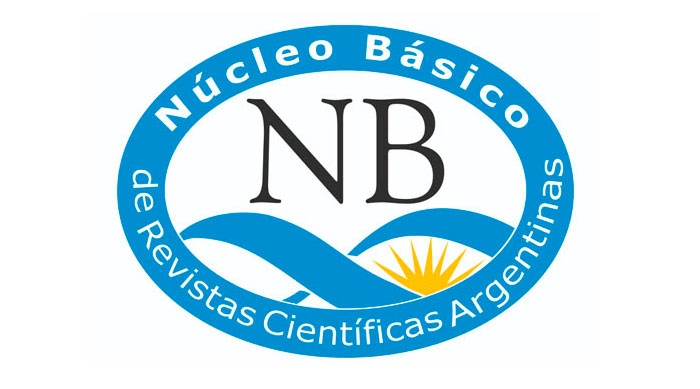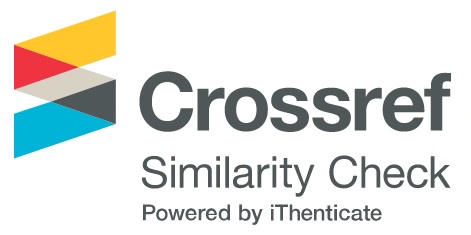Optimization of tissue culture conditions and in vitro and in planta transformation of the local variety of rice Don Justo FCAyF
DOI:
https://doi.org/10.24215/16699513e100Keywords:
biotechnology, Oryza sativa, in planta transformation, in vitro cultureAbstract
Rice (Oryza sativa L.) is one of the most economically important cereals because it provides food for more than half of the world's population. Improving this crop through genetic engineering requires fine-tuning processes such as tissue culture and transformation. Here, we optimized tissue in vitro culture and transformation methods of the local premium cultivar Don Justo FCAyF. Regarding tissue culture, the optimal 2,4D concentration was 3 mg.l-1showing 42% of callogenesis. Shoot regeneration showed 77% efficiency using a combination of 4 mg.l-1 BAP and 0.8 mg.l-1 NAA. About Agrobacterium tumefaciens transformation we obtained variable results depending on the plasmid as well as the explant used. In the case of in vitro transformation of embryogenic calli, values between 14-29% were obtained depending on the plasmid. While, in planta methods of embryo transformation presented an efficiency between 3-28%. In conclusion, in this work the methods for tissue cultivation and Agrobacterium transformation of a local variety of rice were fine-tuned. These results will facilitate its genetic improvement through different techniques such as conventional transgenesis or gene editing.
Downloads
Metrics
References
Aguilar-Bartels, C.; P. Quirós-Segura; A. García-Piñeres; A. Gatica-Arias & G. Arrieta-Espinoza (2021). Aspectos clave para la transformación genética de arroz (Oryza sativa L.) subespecie indica mediante Agrobacterium tumefaciens. Agronomía Mesoamericana 32: 764-778.
Ahmed, T.; S. Biswas; S.M. Elias; M. Sazzadur Rahman; N. Tuteja & Z.I. Seraj (2017).In planta transformation for conferring salt tolerance to a tissue-culture unresponsive indica rice (Oryza sativa L.) cultivar. In Vitro Cellular & Developmental Biology Plant 54: 154-165.
Andrieu, A.; J.C. Breitler; C. Siré; D. Meynard; P. Gantet & E. Guiderdoni (2012). An in planta, Agrobacterium-mediated transient gene expression method for inducing gene silencing in rice (Oryza sativa L.) leaves. Rice 5(1): 23.
Ausubel, F.; R. Brent; R. Kingston; D. Moore; J. Smith; J. Seidman & K. Struhl (1987). Current protocols in molecular biology. New York: John Wiley & Sons, Inc. 4755 pp.
Bartlett, J.G.; S.C. Alves; M. Smedley; J.W. Snape & W.A. Harwood (2008). High-throughput Agrobacterium-mediated barley transformation. Plant Methods 4(1): 22.
Binte Mostafiz, S. & A. Wagiran (2018). Efficient callus induction and regeneration in selected indica rice. Agronomy 8(5): 77.
Biswas, G.C.G. & F.J. Zapata (1993). High-frequency plant regeneration from protoplasts of indica rice (Oryza sativa L.) using maltose. Journal of Plant Physiology 141(4): 470-475.
Clough, S.J. & A.F. Bent (1998). Floral dip: a simplified method for Agrobacterium -mediated transformation of Arabidopsis thaliana. The Plant Journal 16(6): 735-743.
Food and Agriculture Organization of the United Nations. FAO (2002). Producción de cultivos, perspectivas por sectores principales. Disponible en: http://www.fao.org/3/y3557s/y3557s04.pdf. Último acceso: 31 de julio 2022.
Hamada, H.; Q. Linghu; Y. Nagira; R. Miki; N. Taoka & R. Imai (2017). An in planta biolistic method for stable wheat transformation. Scientific Reports 7(1): 11443.
Hiei, Y. & T. Komari (2008). Agrobacterium-mediated transformation of rice using immature embryos or calli induced from mature seed. Nature Protocols 3(5): 824-834.
Husaini, A.M.; M.Z. Abdin; G.A. Parray; G.S. Sanghera; I. Murtaza; T. Alam; D.K. Srivastava; H. Farooqi & H.N. Khan (2010). Vehicles and ways for efficient nuclear transformation in plants. GM Crops 1(5): 276-287.
Lin, J.; B. Zhou; Y. Yang; J. Mei; X. Zhao; X. Guo; X. Huang; D. Tang; X. Liu (2009). Piercing and vacuum infiltration of the mature embryo: a simplified method for Agrobacterium-mediated transformation of indica rice. Plant Cell Reports 28(7): 1065-1074.
Liu, Y.; W. Luo; Q. Linghu; F. Abe; H. Hisano; K. Sato; Y. Kamiya; K. Kawaura; K. Onishi; M. Endo; S. Toki; H. Hamada; Y. Nagira; N. Taoka & R. Imai (2021). In planta genome editing in commercial wheat varieties. Frontiers in Plant Science 12(388).
Malzahn, A.; L. Lowder & Y. Qi (2017). Plant genome editing with TALEN and CRISPR. Cell & Bioscience 7(1): 21.
McCouch, S.R.; M.H. Wright; C.W. Tung; L.G. Maron; K.L. McNally; M. Fitzgerald; N. Singh; G. DeClerck; F. Agosto-Perez; P. Korniliev; A.J. Greenberg, M.E.B. Naredo; S.M.Q. Mercado; S.E. Harrington; Y. Shi; D.A. Branchini; P.R. Kuser-Falcão; H. Leung; K. Ebana,… J. Mezey (2016). Open access resources for genome-wide association mapping in rice. Nature Communications 7(1): 10532.
Mohammed, S.; A.A. Samad & Z. Rahmat (2019).Agrobacterium-mediated transformation of rice: constraints and possible solutions. Rice Science 26(3): 133-146.
Murashige, T. & F. Skoog (1962). A revised medium for rapid growth and bio assays with tobacco tissue cultures. Physiologia Plantarum 15(3): 473-497.
Pazuki, A. & M. Sohani (2013). Phenotypic evaluation of scutellum-derived calluses in ‘Indica’ rice cultivars. Acta Agriculturae Slovenica 101: 239-247.
Ratanasut, K.; W. Rod-In & K. Sujipuli (2017). In planta Agrobacterium-mediated transformation of rice. Rice Science 24(3): 181-186.
Rod-in, W.; K. Sujipuli & K. Ratanasut (2014). The floral-dip method for rice (Oryza sativa) transformation. Journal of Agricultural Technology 10(2): 467-474.
Romero, F.M. & A. Gatica-Arias (2019). CRISPR/Cas9: development and application in rice breeding. Rice Science 26(5): 265-281.
Saba-Mayoral, A.; L. Bassie; P. Christou & T. Capell (2022). Development of a facile genetic transformation system for the Spanish elite rice paella genotype Bomba. Transgenic Research 31(3): 325-340.
Sahoo, K.K.; A.K. Tripathi; A. Pareek; S.K. Sopory & S.L. Singla-Pareek (2011). An improved protocol for efficient transformation and regeneration of diverse indica rice cultivars. Plant Methods 7(1): 49.
Sasaki, T. & B. Burr (2000). International rice genome sequencing project: the effort to completely sequence the rice genome. Current Opinion in Plant Biology 3(2): 138-142.
Shimamoto, K. & J. Kyozuka (2002). Rice as a model for comparative genomics of plants. Annual Review of Plant Biology 53(1): 399-419.
Smith, C.W. & R.H. Dilday (2002). Rice: origin, history, technology, and production. C.W. Smith & R.H. Dilday Ed. Wiley Series in Crop Science. 664 pp.
Sood, P.; A. Bhattacharya & A. Sood (2011). Problems and possibilities of monocot transformation. Biologia Plantarum 55(1): 1-15.
Supartana, P.; T. Shimizu; H. Shioiri; M. Nogawa; M. Nozue & M. Kojima (2005). Development of simple and efficient in planta transformation method for rice (Oryza sativa L.) using Agrobacterium tumefaciens. Journal of Bioscience and Bioengineering 100(4): 391-397.
Tripathy, S.K. (2021). Optimization of culture variables for efficient callus induction and rapid plant regeneration in zinc rich rice (Oryza sativa L.) cv. “Chittimuthyalu”. Journal of Applied Biology & Biotechnology 9(4): 1-9.
Tripathy, S.K.; M. Maharana; S. Panda; B. Sahoo; D.B. Sahoo; S.K. Behera & B. Chakma (2018). Exploring efficient callusing and rapid regeneration system in upland rice (Oryza sativa L.). Rice Genomics and Genetics 9(2): 7-14.
Turnbull, C.; M. Lillemo & T.A.K. Hvoslef-Eide (2021). Global regulation of genetically modified crops amid the gene edited crop boom – a review. Frontiers in Plant Science 12.
Vazquez-Vilar, M.; V. Garcia-Carpinter; S. Selma; J.M. Bernabé-Orts; J. Sanchez-Vicente; B. Salazar-Sarasua; A. Ressa; C. de Paola; M. Ajenjo; J.C. Quintela; A. Fernández; A. Granell & D. Orzáez (2021). The GB4.0 platform, an all-in-one tool for CRISPR/Cas-based multiplex genome engineering in plants. Frontiers in Plant Science 12: 689937-689937.
Vega, R.; N. Vásquez; A.M. Espinoza; A.M. Gatica & M. Valdez-Melara (2009). Histology of somatic embryogenesis in rice (Oryza sativa cv. 5272). Revista de Biologia Tropical 57: 141-150.
Yaqoob, U.; T. Kaul & I.A. Nawchoo (2021).In vitro plant regeneration of some recalcitrant indica rice (Oryza sativa L.) varieties. Vegetos 34(1): 102-106.
Downloads
Published
How to Cite
Issue
Section
License
Copyright (c) 2022 Martín Andrés Duhalde, Rodolfo Bezus, Andrés Alberto Rodriguez, Santiago Javier Maiale, Fernando Matias Romero

This work is licensed under a Creative Commons Attribution-NonCommercial-ShareAlike 4.0 International License.
A partir de 2019 (Vol. 118 número 2) los artículos se publicarán en la revista bajo una licencia Creative Commons Atribución- NoComercial-CompartirIgual 4.0 Internacional (CC BY-NC-SA 4.0)
Acorde a estos términos, el material se puede compartir (copiar y redistribuir en cualquier medio o formato) y adaptar (remezclar, transformar y crear a partir del material otra obra), siempre que a) se cite la autoría y la fuente original de su publicación (revista y URL de la obra), b) no se use para fines comerciales y c) se mantengan los mismos términos de la licencia.
Previo a esta fecha los artículos se publicaron en la revista bajo una licencia Creative Commons Atribución (CC BY)
En ambos casos, la aceptación de los originales por parte de la revista implica la cesión no exclusiva de los derechos patrimoniales de los/as autores/as en favor del editor, quien permite la reutilización, luego de su edición (posprint), bajo la licencia que corresponda según la edición.
Tal cesión supone, por un lado, que luego de su edición (posprint) en Revista de la Facultad de Agronomía las/os autoras/es pueden publicar su trabajo en cualquier idioma, medio y formato (en tales casos, se solicita que se consigne que el material fue publicado originalmente en esta revista); por otro, la autorización de los/as autores/as para que el trabajo sea cosechado por SEDICI, el repositorio institucional de la Universidad Nacional de La Plata, y sea difundido en las bases de datos que el equipo editorial considere adecuadas para incrementar la visibilidad de la publicación y de sus autores/as.
Asimismo, la revista incentiva a las/os autoras/es para que luego de su publicación en Revista de la Facultad de Agronomía depositen sus producciones en otros repositorios institucionales y temáticos, bajo el principio de que ofrecer a la sociedad la producción científica y académica sin restricciones contribuye a un mayor intercambio del conocimiento global.































